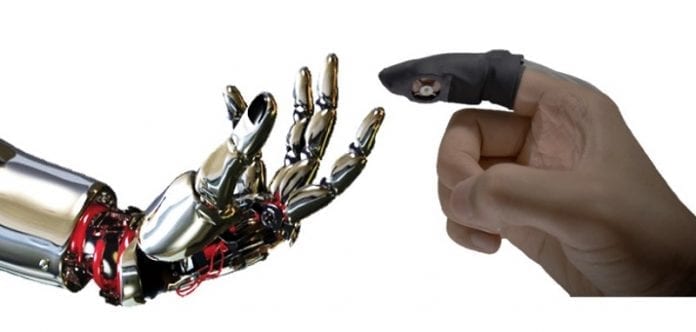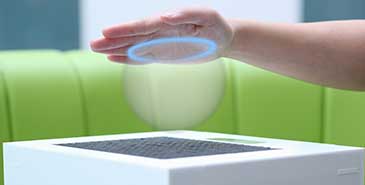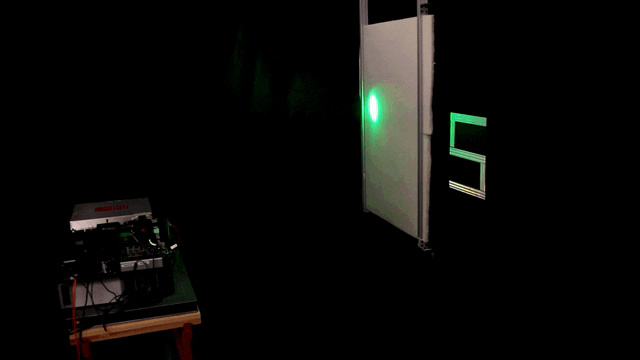
UNSW Engineering researchers have developed a new soft skin stretch device (SSD) which can be integrated into fabric, such as the finger glove pictured which is contrasted with a stylised robotic hand. Image: UNSW Engineering
UNSW engineers have invented a soft wearable device which simulates the sense of touch and has wide potential for medical, industrial and entertainment applications.
What if you could touch a loved one during a video call – particularly in today’s social distancing era of COVID-19 – or pick up and handle a virtual tool in a video game?
Pending user tests and funding to commercialise the new technology, these ideas could become reality in a couple of years after UNSW Sydney engineers developed a new haptic device which recreates the sense of touch.
Haptic technology mimics the experience of touch by stimulating localised areas of the skin in ways that are similar to what is felt in the real world, through force, vibration or motion.
Dr Thanh Nho Do, Scientia Lecturer and UNSW Medical Robotics Lab director, is senior author of a study featuring the new device.
His research team featured lead author and PhD candidate Mai Thanh Thai, Phuoc Thien Phan, Trung Thien Hoang and collaborator Scientia Professor Nigel Lovell, Head of the Graduate School of Biomedical Engineering.
Dr Do said the sense of touch was something many people took for granted to perform everyday tasks.
“When we do things with our hands, such as holding a mobile phone or typing on a keyboard, all of these actions are impossible without haptics,” he said.
“The human hand has a high density of tactile receptors and is both an interesting and challenging area to encode information through haptic stimulation, because we use our hands to perceive most objects every day.
“There are many situations where the sense of touch would be useful but is impossible: for example, in a telehealth consultation a doctor is unable to physically examine a patient. So, we aimed to solve this problem.”
The Latest Updates from Bing News & Google News
Go deeper with Bing News on:
Haptic device
- Nanoprinting turns textiles into multipurpose health monitoring devices
Today, we see a range of devices that hint at this potential, from smartwatches that track our fitness to clothing with built-in haptic feedback for immersive gaming experiences. But despite these ...
- iPad 2024 Latest Leak: Apple May Reveal All-New iPad Accessory In Days
The next Apple special event is around a week away, and as well as new iPads, we think we know details of a key new accessory.
- The Apple Pencil 3 could arrive next week and have a haptic surprise
The Apple Pencil 3 could be announced during the May 7 iPad event and a new report claims that it'll have haptic feedback support for the first time.
- New iPad Pro may use an AI-enabled M4 chip and the Apple Pencil 3 may have haptic feedback
With the latest M4 chip, the new iPad Pro could be positioned as Apple's first AI-powered device, says Bloomberg's Mark Gurman.
- Apple Pencil 3: Haptic Feedback, New Gestures Coming for iPad Accessory
For this year's update, the Apple Pencil 3 would bring additional features like haptic feedback and new gestures to enjoy for the device. In Gurman's report, he regarded that massive new features are ...
Go deeper with Google Headlines on:
Haptic device
[google_news title=”” keyword=”haptic device” num_posts=”5″ blurb_length=”0″ show_thumb=”left”]
Go deeper with Bing News on:
Haptic technology
- ECS receives SBIR award for Advanced Haptics Development project
Engineering & Computer Simulations (ECS), a provider of extended reality (XR) training solutions, has recently announced that it has received a Small Business Innovation ...
- 5 considerations when choosing a haptics manufacturer
That said, the manufacturing of haptic products is no small feat. It requires a blend of multidisciplinary expertise, careful consideration of user experience, seamless integration of technology, ...
- Razer Kishi Ultra is a full-sized controller for iOS and Android with DualSense-like haptics
The Razer Kishi Ultra is a full-sized USB-C controller for Android and iOS devices with pro-grade features and new Razer Sensa HD Haptics technology.
- Buy Rating Affirmed for Immersion (IMMR) on Strong Financials and Strategic Investments in Haptics and Education Sectors
Immersion (IMMR – Research Report), the Technology sector company, was revisited by a Wall Street analyst today. Analyst Hamed Khorsand ...
- What Are Haptics on iPhone Devices and Why Do They Exist?
Apple's high design standards and widespread popularity mean that more people than ever have the option of using haptic technology with their smartphones. That said, what are haptics on iPhone devices ...
Go deeper with Google Headlines on:
Haptic technology
[google_news title=”” keyword=”haptic technology” num_posts=”5″ blurb_length=”0″ show_thumb=”left”]










